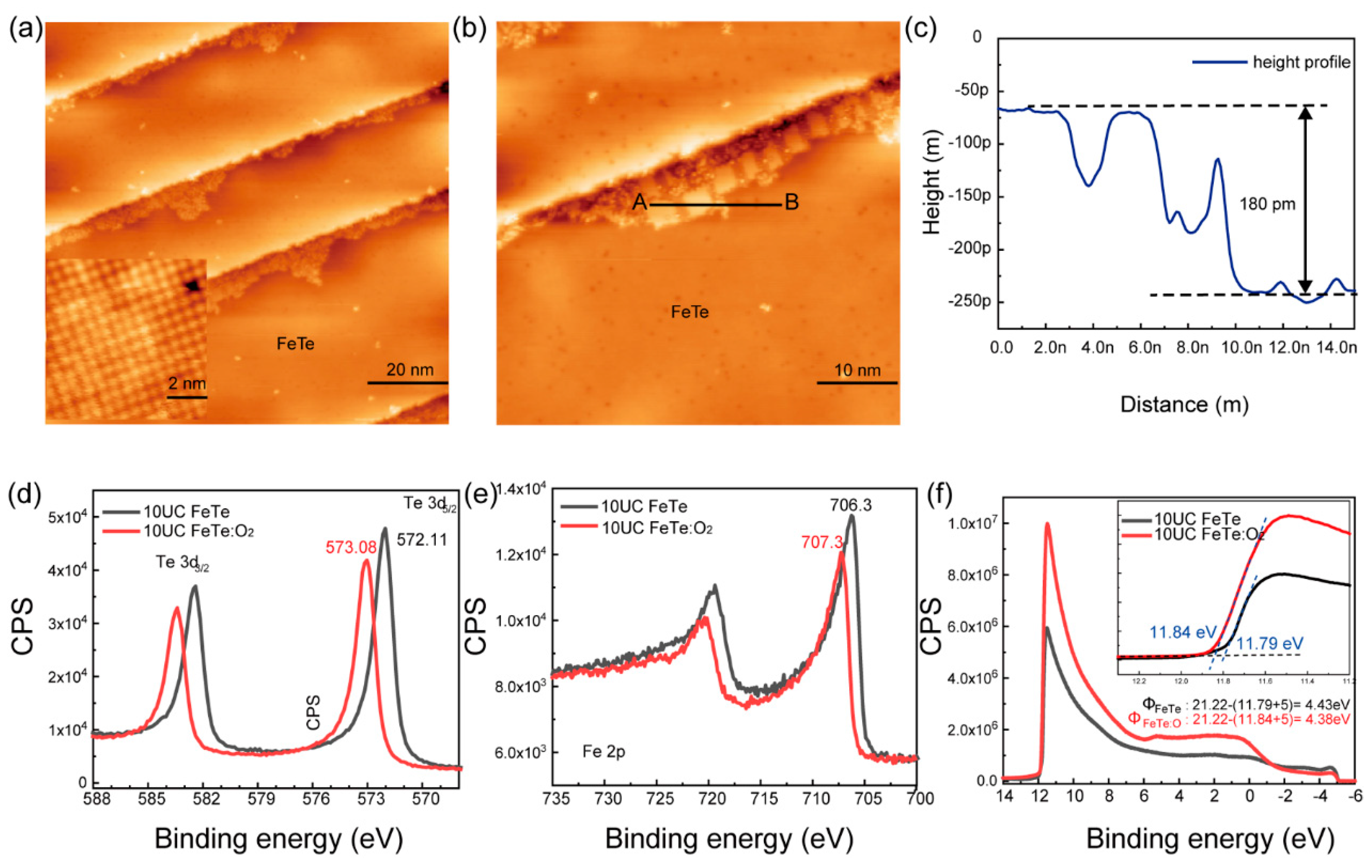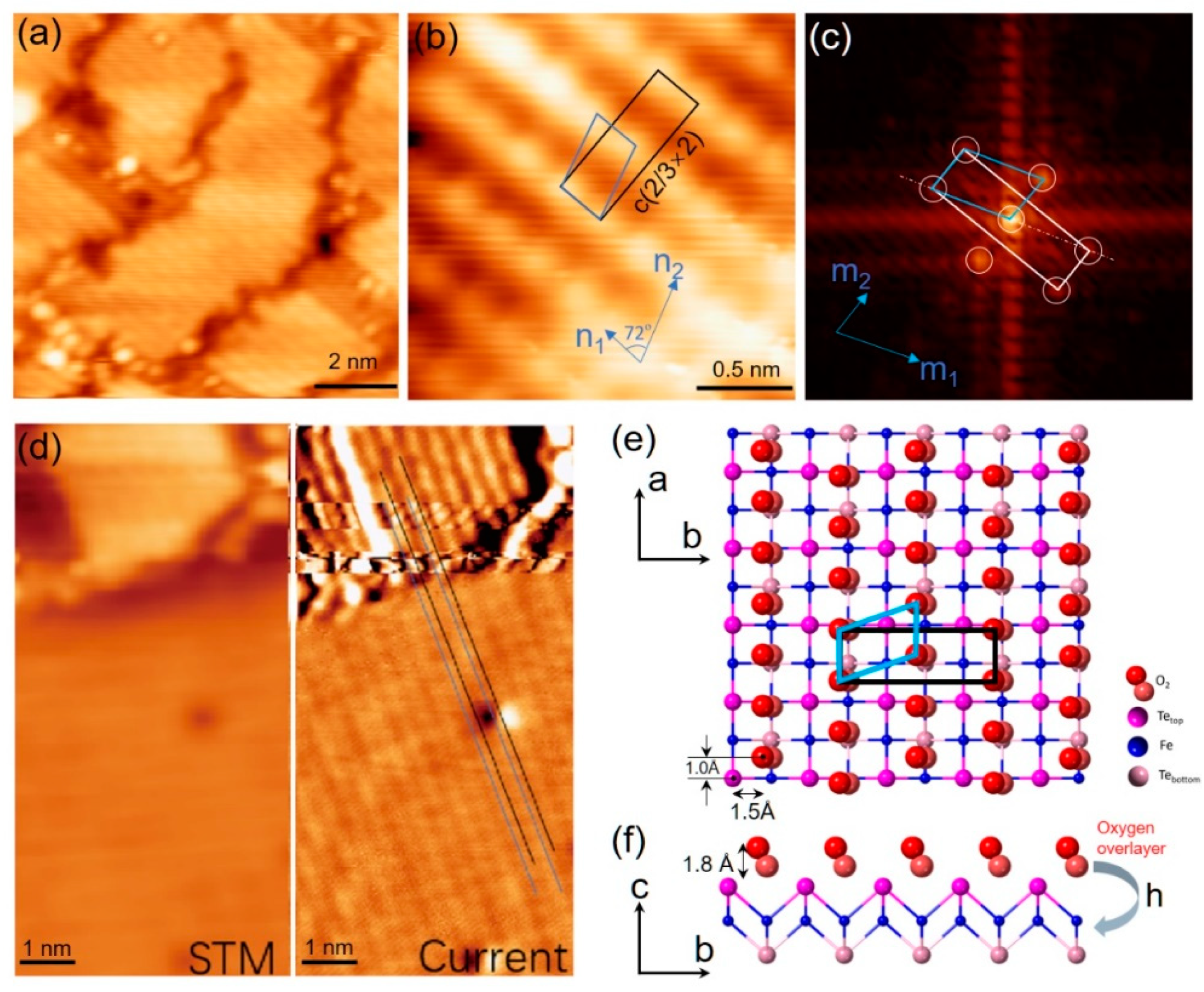Oxygen Adsorption Induced Superconductivity in Ultrathin FeTe Film on SrTiO3(001)
Abstract
:1. Introduction
2. Materials and Methods
3. Results
4. Conclusions
Supplementary Materials
Author Contributions
Funding
Institutional Review Board Statement
Informed Consent Statement
Data Availability Statement
Acknowledgments
Conflicts of Interest
Abbreviations
| AFM | Antiferromagnetic |
| UC | Unit-Cell |
| UHV | Ultrahigh Vacuum |
| BE | Binding Energy |
| LDOS | Local Density of State |
| STO | SrTiO3 |
| STM | Scanning Tunneling Microscopy |
| STS | Scanning Tunneling Spectroscopy |
| XPS | X-ray Photoelectron Spectroscopy |
| UPS | Ultraviolet Photoelectron Spectrometer |
| MBE | Molecular Beam Epitaxy |
References
- Wang, Q.-Y.; Li, Z.; Zhang, W.-H.; Zhang, Z.-C.; Zhang, J.-S.; Li, W.; Ding, H.; Ou, Y.-B.; Deng, P.; Chang, K.; et al. Interface-induced high-temperature superconductivity in single unit-cell FeSe films on SrTiO3. Chin. Phys. Lett. 2012, 29, 037402. [Google Scholar] [CrossRef] [Green Version]
- Li, F.; Ding, H.; Tang, C.; Peng, J.; Zhang, Q.; Zhang, W.; Zhou, G.; Zhang, D.; Song, C.-L.; He, K.; et al. Interface-enhanced high-temperature superconductivity in single-unit-cell FeTe1−xSex films onSrTiO3. Phys. Rev. B 2015, 91, 220503(R). [Google Scholar] [CrossRef]
- Lee, J.J.; Schmitt, F.T.; Moore, R.G.; Johnston, S.; Cui, Y.T.; Li, W.; Yi, M.; Liu, Z.K.; Hashimoto, M.; Zhang, Y.; et al. Interfacial mode coupling as the origin of the enhancement of T(c) in FeSe films on SrTiO3. Nature 2014, 515, 245–248. [Google Scholar] [CrossRef]
- Wang, D.; Kong, L.; Fan, P.; Chen, H.; Zhu, S.; Liu, W.; Cao, L.; Sun, Y.; Du, S.; Schneeloch, J.; et al. Evidence for Majorana bound states in an iron-based superconductor. Science 2018, 362, 333–335. [Google Scholar] [CrossRef] [PubMed] [Green Version]
- Zhang, P.; Yaji, K.; Hashimoto, T.; Ota, Y.; Kondo, T.; Okazaki, K.; Wang, Z.J.; Wen, J.S.; Gu, G.D.; Ding, H.; et al. Observation of topological superconductivity on the surface of an iron-based superconductor. Science 2018, 360, 182. [Google Scholar] [CrossRef] [Green Version]
- Xu, G.; Lian, B.; Tang, P.; Qi, X.L.; Zhang, S.C. Topological superconductivity on the surface of Fe-based superconductors. Phys. Rev. Lett. 2016, 117, 047001. [Google Scholar] [CrossRef] [Green Version]
- Jiang, D.; Pan, Y.; Wang, S.; Lin, Y.; Holland, C.M.; Kirtley, J.R.; Chen, X.; Zhao, J.; Chen, L.; Yin, S.; et al. Observation of robust edge superconductivity in Fe(Se,Te) under strong magnetic perturbation. Sci. Bull. 2021, 66, 425–432. [Google Scholar] [CrossRef]
- Enayat, M.; Sun, Z.X.; Singh, U.R.; Aluru, R.; Schmaus, S.; Yaresko, A.; Liu, Y.; Lin, C.T.; Tsurkan, V.; Loidl, A.; et al. Real-space imaging of the atomic-scale magnetic structure of Fe1+yTe. Science 2014, 345, 653–656. [Google Scholar] [CrossRef] [PubMed] [Green Version]
- Trainer, C.; Yim, C.M.; Heil, C.; Giustino, F.; Croitori, D.; Tsurkan, V.; Loidl, A.; Rodriguez, E.E.; Stock, C.; Wahl, P. Manipulating surface magnetic order in iron telluride. Sci. Adv. 2019, 5, eaav3478. [Google Scholar] [CrossRef] [PubMed] [Green Version]
- Dagotto, E. Colloquium: The unexpected properties of alkali metal iron selenide superconductors. Rev. Mod. Phys. 2013, 85, 849–867. [Google Scholar] [CrossRef] [Green Version]
- Nie, Y.F.; Telesca, D.; Budnick, J.I.; Sinkovic, B.; Wells, B.O. Superconductivity induced in iron telluride films by low-temperature oxygen incorporation. Phys. Rev. B 2010, 82, 020508(R). [Google Scholar] [CrossRef] [Green Version]
- Zheng, M. Growth and Oxygen Doping of Thin Film FeTe by Molecular Beam Epitaxy. Available online: http://hdl.handle.net/2142/46712 (accessed on 15 August 2021).
- Hu, H.; Kwon, J.-H.; Zheng, M.; Zhang, C.; Greene, L.H.; Eckstein, J.N.; Zuo, J.-M. Impact of interstitial oxygen on the electronic and magnetic structure in superconducting Fe1+yTeOx thin films. Phys. Rev. B 2014, 90, 180504(R). [Google Scholar] [CrossRef] [Green Version]
- Zhao, P.H.; Zhu, H.F.; Tian, Y.J.; Li, D.L.; Ma, L.; Suo, H.L.; Nie, J.C. O2 Annealing Induced Superconductivity in FeTe1−xSex: On the Origin of Superconductivity in FeTe Films. J. Super. Nov. Magn. 2016, 30, 871–876. [Google Scholar] [CrossRef]
- Mizuguchi, Y.; Deguchi, K.; Tsuda, S.; Yamaguchi, T.; Takano, Y. Evolution of superconductivity by oxygen annealing in FeTe0.8S0.2. Europhys. Lett. 2010, 90. [Google Scholar] [CrossRef] [Green Version]
- Hu, H.; Zuo, J.-M.; Zheng, M.; Eckstein, J.N.; Park, W.K.; Greene, L.H.; Wen, J.; Xu, Z.; Lin, Z.; Li, Q.; et al. Structure of the oxygen-annealed chalcogenide superconductor Fe1.08Te0.55Se0.45Ox. Phys. Rev. B 2012, 85, 064504. [Google Scholar] [CrossRef] [Green Version]
- Su, T.S.; Yin, Y.W.; Teng, M.L.; Gong, Z.Z.; Zhang, M.J.; Li, X.G. Effect of carrier density and valence states on superconductivity of oxygen annealed Fe1.06Te0.6Se0.4 single crystals. J. Appl. Phys. 2013, 114. [Google Scholar] [CrossRef]
- Sun, Y.; Tsuchiya, Y.; Taen, T.; Yamada, T.; Pyon, S.; Sugimoto, A.; Ekino, T.; Shi, Z.; Tamegai, T. Dynamics and mechanism of oxygen annealing in Fe1+yTe0.6Se0.4 single crystal. Sci. Rep. 2014, 4, 4585. [Google Scholar] [CrossRef] [Green Version]
- Yamazaki, T.; Sakurai, T.; Yaguchi, H. Size Dependence of oxygen-annealing effects on superconductivity of Fe1+yTe1-xSx. J. Phys. Soc. Jpn. 2016, 85, 114712. [Google Scholar] [CrossRef] [Green Version]
- Dong, L.; Zhao, H.; Zeljkovic, I.; Wilson, S.D.; Harter, J.W. Bulk superconductivity in FeTe1-xSex via physicochemical pumping of excess iron. Phys. Rev. Mater. 2019, 3, 114801. [Google Scholar] [CrossRef]
- Ru, H.; Lin, Y.-S.; Chen, Y.-C.; Feng, Y.; Wang, Y.-H. Observation of two-level critical state in the superconducting FeTe thin films. Chin. Phys. Lett. 2019, 36, 077402. [Google Scholar] [CrossRef] [Green Version]
- Kawasaki, Y.; Deguchi, K.; Demura, S.; Watanabe, T.; Okazaki, H.; Ozaki, T.; Yamaguchi, T.; Takeya, H.; Takano, Y. Phase diagram and oxygen annealing effect of FeTe1-xSex iron-based superconductor. Solid State Commun. 2012, 152, 1135–1138. [Google Scholar] [CrossRef] [Green Version]
- Si, W.; Jie, Q.; Wu, L.; Zhou, J.; Gu, G.; Johnson, P.D.; Li, Q. Superconductivity in epitaxial thin films of Fe1.08Te:Ox. Phys. Rev. B 2010, 81, 092506. [Google Scholar] [CrossRef]
- Horcas, I.; Fernandez, R.; Gomez-Rodriguez, J.M.; Colchero, J.; Gomez-Herrero, J.; Baro, A.M. WSXM: A software for scanning probe microscopy and a tool for nanotechnology. Rev. Sci. Instrum. 2007, 78, 013705. [Google Scholar] [CrossRef] [PubMed]
- Zhang, W.-H.; Sun, Y.; Zhang, J.-S.; Li, F.-S.; Guo, M.-H.; Zhao, Y.-F.; Zhang, H.-M.; Peng, J.-P.; Xing, Y.; Wang, H.-C.; et al. Direct Observation of high-temperature superconductivity in one-unit-cell FeSe films. Chin. Phys. Lett. 2014, 31, 017401. [Google Scholar] [CrossRef] [Green Version]
- Liang, J.; Zhang, Y.J.; Yao, X.; Li, H.; Li, Z.-X.; Wang, J.; Chen, Y.; Sou, I.K. Studies on the origin of the interfacial superconductivity of Sb2Te3/Fe1+yTe heterostructures. Proc. Natl. Acad. Sci. USA 2020, 117, 221–227. [Google Scholar] [CrossRef] [PubMed] [Green Version]
- Telesca, D.; Nie, Y.; Budnick, J.I.; Wells, B.O.; Sinkovic, B. Impact of valence states on the superconductivity of iron telluride and iron selenide films with incorporated oxygen. Phys. Rev. B 2012, 85, 214517. [Google Scholar] [CrossRef] [Green Version]
- Zhang, Z.T.; Yang, Z.R.; Lu, W.J.; Chen, X.L.; Li, L.; Sun, Y.P.; Xi, C.Y.; Ling, L.S.; Zhang, C.J.; Pi, L.; et al. Superconductivity in Fe1.05Te:Ox single crystals. Phys. Rev. B 2013, 88, 214511. [Google Scholar] [CrossRef]
- Smith, N.; Gelting, D.; Basaran, A.C.; Schofield, M.; Schuller, I.K.; Gajdardziska-Josifovska, M.; Guptasarma, P. Effects of oxygen annealing on single crystal iron telluride. Phys. C Supercond. 2019, 567, 1253400. [Google Scholar] [CrossRef]
- Zhang, Z.; Cai, M.; Li, R.; Meng, F.; Zhang, Q.; Gu, L.; Ye, Z.; Xu, G.; Fu, Y.-S.; Zhang, W. Controllable synthesis and electronic structure characterization of multiple phases of iron telluride thin films. Phys. Rev. Mater. 2020, 4, 125003. [Google Scholar] [CrossRef]
- Song, Y.; Ying, T.; Chen, X.; Han, X.; Huang, Y.; Wu, X.; Schnyder, A.-P.; Guo, J.; Chen, X. Enhancement of superconductivity in hole-doped CsV3Sb5 thin films. arXiv 2021, arXiv:2105.09898v1. [Google Scholar]
- Qn, H.; Guo, B.; Wang, L.; Zhang, M.; Xu, B.; Shi, K.; Pan, T.; Zhou, L.; Chen, J.; Qu, Y.; et al. Superconductivity in single-quintuple-layer Bi2Te3 grown on epitaxial FeTe. Nano Lett. 2020, 20, 3160–3168. [Google Scholar] [CrossRef] [PubMed]
- Owada, K.; Nakayama, K.; Tsubono, R.; Shigekawa, K.; Sugawara, K.; Takahashi, T.; Sato, T. Electronic structure of a Bi2Te3/FeTe heterostructure: Implications for unconventional superconductivity. Phys. Rev. B 2019, 100, 064518. [Google Scholar] [CrossRef] [Green Version]
- Guo, B.; Shi, K.-G.; Qin, H.-L.; Zhou, L.; Chen, W.-Q.; Ye, F.; Mei, J.-W.; He, H.-T.; Pan, T.-L.; Wang, G. Evidence for topological superconductivity: Topological edge states in Bi2Te3/FeTe heterostructure. Chin. Phys. B 2020, 29, 097403. [Google Scholar] [CrossRef]
- Yuan, Y.; Wang, X.; Song, C.; Wang, L.; He, K.; Ma, X.; Yao, H.; Li, W.; Xue, Q.-K. Observation of coulomb gap and enhanced superconducting gap in nano-sized Pb islands grown on SrTiO3. Chin. Phys. Lett. 2020, 37, 017402. [Google Scholar] [CrossRef]




Publisher’s Note: MDPI stays neutral with regard to jurisdictional claims in published maps and institutional affiliations. |
© 2021 by the authors. Licensee MDPI, Basel, Switzerland. This article is an open access article distributed under the terms and conditions of the Creative Commons Attribution (CC BY) license (https://creativecommons.org/licenses/by/4.0/).
Share and Cite
Ren, W.; Ru, H.; Peng, K.; Li, H.; Lu, S.; Chen, A.; Wang, P.; Fang, X.; Li, Z.; Huang, R.; et al. Oxygen Adsorption Induced Superconductivity in Ultrathin FeTe Film on SrTiO3(001). Materials 2021, 14, 4584. https://doi.org/10.3390/ma14164584
Ren W, Ru H, Peng K, Li H, Lu S, Chen A, Wang P, Fang X, Li Z, Huang R, et al. Oxygen Adsorption Induced Superconductivity in Ultrathin FeTe Film on SrTiO3(001). Materials. 2021; 14(16):4584. https://doi.org/10.3390/ma14164584
Chicago/Turabian StyleRen, Wei, Hao Ru, Kun Peng, Huifang Li, Shuai Lu, Aixi Chen, Pengdong Wang, Xinwei Fang, Zhiyun Li, Rong Huang, and et al. 2021. "Oxygen Adsorption Induced Superconductivity in Ultrathin FeTe Film on SrTiO3(001)" Materials 14, no. 16: 4584. https://doi.org/10.3390/ma14164584
APA StyleRen, W., Ru, H., Peng, K., Li, H., Lu, S., Chen, A., Wang, P., Fang, X., Li, Z., Huang, R., Wang, L., Wang, Y., & Li, F. (2021). Oxygen Adsorption Induced Superconductivity in Ultrathin FeTe Film on SrTiO3(001). Materials, 14(16), 4584. https://doi.org/10.3390/ma14164584





